Shufei Zhang
Plan Then Action:High-Level Planning Guidance Reinforcement Learning for LLM Reasoning
Oct 02, 2025Abstract:Large language models (LLMs) have demonstrated remarkable reasoning abilities in complex tasks, often relying on Chain-of-Thought (CoT) reasoning. However, due to their autoregressive token-level generation, the reasoning process is largely constrained to local decision-making and lacks global planning. This limitation frequently results in redundant, incoherent, or inaccurate reasoning, which significantly degrades overall performance. Existing approaches, such as tree-based algorithms and reinforcement learning (RL), attempt to address this issue but suffer from high computational costs and often fail to produce optimal reasoning trajectories. To tackle this challenge, we propose Plan-Then-Action Enhanced Reasoning with Group Relative Policy Optimization PTA-GRPO, a two-stage framework designed to improve both high-level planning and fine-grained CoT reasoning. In the first stage, we leverage advanced LLMs to distill CoT into compact high-level guidance, which is then used for supervised fine-tuning (SFT). In the second stage, we introduce a guidance-aware RL method that jointly optimizes the final output and the quality of high-level guidance, thereby enhancing reasoning effectiveness. We conduct extensive experiments on multiple mathematical reasoning benchmarks, including MATH, AIME2024, AIME2025, and AMC, across diverse base models such as Qwen2.5-7B-Instruct, Qwen3-8B, Qwen3-14B, and LLaMA3.2-3B. Experimental results demonstrate that PTA-GRPO consistently achieves stable and significant improvements across different models and tasks, validating its effectiveness and generalization.
ChemBOMAS: Accelerated BO in Chemistry with LLM-Enhanced Multi-Agent System
Sep 10, 2025Abstract:The efficiency of Bayesian optimization (BO) in chemistry is often hindered by sparse experimental data and complex reaction mechanisms. To overcome these limitations, we introduce ChemBOMAS, a new framework named LLM-Enhanced Multi-Agent System for accelerating BO in chemistry. ChemBOMAS's optimization process is enhanced by LLMs and synergistically employs two strategies: knowledge-driven coarse-grained optimization and data-driven fine-grained optimization. First, in the knowledge-driven coarse-grained optimization stage, LLMs intelligently decompose the vast search space by reasoning over existing chemical knowledge to identify promising candidate regions. Subsequently, in the data-driven fine-grained optimization stage, LLMs enhance the BO process within these candidate regions by generating pseudo-data points, thereby improving data utilization efficiency and accelerating convergence. Benchmark evaluations** further confirm that ChemBOMAS significantly enhances optimization effectiveness and efficiency compared to various BO algorithms. Importantly, the practical utility of ChemBOMAS was validated through wet-lab experiments conducted under pharmaceutical industry protocols, targeting conditional optimization for a previously unreported and challenging chemical reaction. In the wet experiment, ChemBOMAS achieved an optimal objective value of 96%. This was substantially higher than the 15% achieved by domain experts. This real-world success, together with strong performance on benchmark evaluations, highlights ChemBOMAS as a powerful tool to accelerate chemical discovery.
CMPhysBench: A Benchmark for Evaluating Large Language Models in Condensed Matter Physics
Aug 25, 2025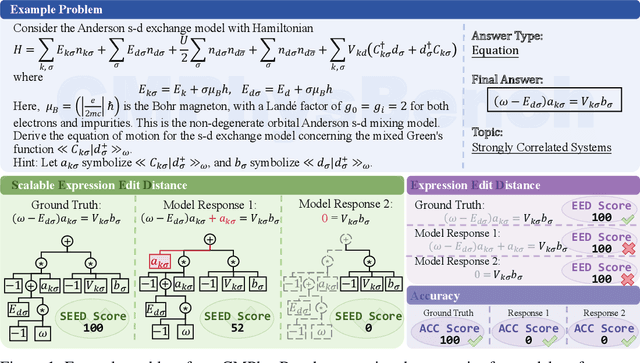
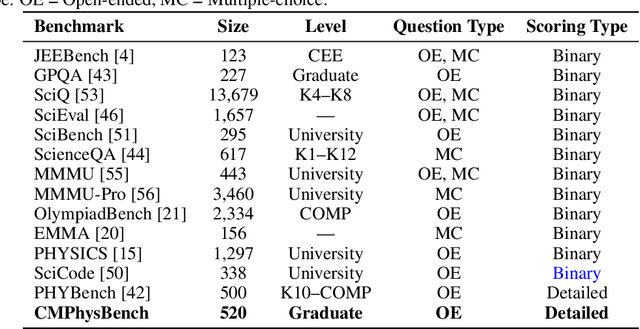


Abstract:We introduce CMPhysBench, designed to assess the proficiency of Large Language Models (LLMs) in Condensed Matter Physics, as a novel Benchmark. CMPhysBench is composed of more than 520 graduate-level meticulously curated questions covering both representative subfields and foundational theoretical frameworks of condensed matter physics, such as magnetism, superconductivity, strongly correlated systems, etc. To ensure a deep understanding of the problem-solving process,we focus exclusively on calculation problems, requiring LLMs to independently generate comprehensive solutions. Meanwhile, leveraging tree-based representations of expressions, we introduce the Scalable Expression Edit Distance (SEED) score, which provides fine-grained (non-binary) partial credit and yields a more accurate assessment of similarity between prediction and ground-truth. Our results show that even the best models, Grok-4, reach only 36 average SEED score and 28% accuracy on CMPhysBench, underscoring a significant capability gap, especially for this practical and frontier domain relative to traditional physics. The code anddataset are publicly available at https://github.com/CMPhysBench/CMPhysBench.
Mol-R1: Towards Explicit Long-CoT Reasoning in Molecule Discovery
Aug 11, 2025Abstract:Large language models (LLMs), especially Explicit Long Chain-of-Thought (CoT) reasoning models like DeepSeek-R1 and QWQ, have demonstrated powerful reasoning capabilities, achieving impressive performance in commonsense reasoning and mathematical inference. Despite their effectiveness, Long-CoT reasoning models are often criticized for their limited ability and low efficiency in knowledge-intensive domains such as molecule discovery. Success in this field requires a precise understanding of domain knowledge, including molecular structures and chemical principles, which is challenging due to the inherent complexity of molecular data and the scarcity of high-quality expert annotations. To bridge this gap, we introduce Mol-R1, a novel framework designed to improve explainability and reasoning performance of R1-like Explicit Long-CoT reasoning LLMs in text-based molecule generation. Our approach begins with a high-quality reasoning dataset curated through Prior Regulation via In-context Distillation (PRID), a dedicated distillation strategy to effectively generate paired reasoning traces guided by prior regulations. Building upon this, we introduce MoIA, Molecular Iterative Adaptation, a sophisticated training strategy that iteratively combines Supervised Fine-tuning (SFT) with Reinforced Policy Optimization (RPO), tailored to boost the reasoning performance of R1-like reasoning models for molecule discovery. Finally, we examine the performance of Mol-R1 in the text-based molecule reasoning generation task, showing superior performance against existing baselines.
Iterative Pretraining Framework for Interatomic Potentials
Jul 27, 2025Abstract:Machine learning interatomic potentials (MLIPs) enable efficient molecular dynamics (MD) simulations with ab initio accuracy and have been applied across various domains in physical science. However, their performance often relies on large-scale labeled training data. While existing pretraining strategies can improve model performance, they often suffer from a mismatch between the objectives of pretraining and downstream tasks or rely on extensive labeled datasets and increasingly complex architectures to achieve broad generalization. To address these challenges, we propose Iterative Pretraining for Interatomic Potentials (IPIP), a framework designed to iteratively improve the predictive performance of MLIP models. IPIP incorporates a forgetting mechanism to prevent iterative training from converging to suboptimal local minima. Unlike general-purpose foundation models, which frequently underperform on specialized tasks due to a trade-off between generality and system-specific accuracy, IPIP achieves higher accuracy and efficiency using lightweight architectures. Compared to general-purpose force fields, this approach achieves over 80% reduction in prediction error and up to 4x speedup in the challenging Mo-S-O system, enabling fast and accurate simulations.
Multiphysics Bench: Benchmarking and Investigating Scientific Machine Learning for Multiphysics PDEs
May 23, 2025Abstract:Solving partial differential equations (PDEs) with machine learning has recently attracted great attention, as PDEs are fundamental tools for modeling real-world systems that range from fundamental physical science to advanced engineering disciplines. Most real-world physical systems across various disciplines are actually involved in multiple coupled physical fields rather than a single field. However, previous machine learning studies mainly focused on solving single-field problems, but overlooked the importance and characteristics of multiphysics problems in real world. Multiphysics PDEs typically entail multiple strongly coupled variables, thereby introducing additional complexity and challenges, such as inter-field coupling. Both benchmarking and solving multiphysics problems with machine learning remain largely unexamined. To identify and address the emerging challenges in multiphysics problems, we mainly made three contributions in this work. First, we collect the first general multiphysics dataset, the Multiphysics Bench, that focuses on multiphysics PDE solving with machine learning. Multiphysics Bench is also the most comprehensive PDE dataset to date, featuring the broadest range of coupling types, the greatest diversity of PDE formulations, and the largest dataset scale. Second, we conduct the first systematic investigation on multiple representative learning-based PDE solvers, such as PINNs, FNO, DeepONet, and DiffusionPDE solvers, on multiphysics problems. Unfortunately, naively applying these existing solvers usually show very poor performance for solving multiphysics. Third, through extensive experiments and discussions, we report multiple insights and a bag of useful tricks for solving multiphysics with machine learning, motivating future directions in the study and simulation of complex, coupled physical systems.
NovelSeek: When Agent Becomes the Scientist -- Building Closed-Loop System from Hypothesis to Verification
May 22, 2025



Abstract:Artificial Intelligence (AI) is accelerating the transformation of scientific research paradigms, not only enhancing research efficiency but also driving innovation. We introduce NovelSeek, a unified closed-loop multi-agent framework to conduct Autonomous Scientific Research (ASR) across various scientific research fields, enabling researchers to tackle complicated problems in these fields with unprecedented speed and precision. NovelSeek highlights three key advantages: 1) Scalability: NovelSeek has demonstrated its versatility across 12 scientific research tasks, capable of generating innovative ideas to enhance the performance of baseline code. 2) Interactivity: NovelSeek provides an interface for human expert feedback and multi-agent interaction in automated end-to-end processes, allowing for the seamless integration of domain expert knowledge. 3) Efficiency: NovelSeek has achieved promising performance gains in several scientific fields with significantly less time cost compared to human efforts. For instance, in reaction yield prediction, it increased from 27.6% to 35.4% in just 12 hours; in enhancer activity prediction, accuracy rose from 0.52 to 0.79 with only 4 hours of processing; and in 2D semantic segmentation, precision advanced from 78.8% to 81.0% in a mere 30 hours.
DSADF: Thinking Fast and Slow for Decision Making
May 13, 2025



Abstract:Although Reinforcement Learning (RL) agents are effective in well-defined environments, they often struggle to generalize their learned policies to dynamic settings due to their reliance on trial-and-error interactions. Recent work has explored applying Large Language Models (LLMs) or Vision Language Models (VLMs) to boost the generalization of RL agents through policy optimization guidance or prior knowledge. However, these approaches often lack seamless coordination between the RL agent and the foundation model, leading to unreasonable decision-making in unfamiliar environments and efficiency bottlenecks. Making full use of the inferential capabilities of foundation models and the rapid response capabilities of RL agents and enhancing the interaction between the two to form a dual system is still a lingering scientific question. To address this problem, we draw inspiration from Kahneman's theory of fast thinking (System 1) and slow thinking (System 2), demonstrating that balancing intuition and deep reasoning can achieve nimble decision-making in a complex world. In this study, we propose a Dual-System Adaptive Decision Framework (DSADF), integrating two complementary modules: System 1, comprising an RL agent and a memory space for fast and intuitive decision making, and System 2, driven by a VLM for deep and analytical reasoning. DSADF facilitates efficient and adaptive decision-making by combining the strengths of both systems. The empirical study in the video game environment: Crafter and Housekeep demonstrates the effectiveness of our proposed method, showing significant improvements in decision abilities for both unseen and known tasks.
Nature-Inspired Population-Based Evolution of Large Language Models
Mar 03, 2025



Abstract:Evolution, the engine behind the survival and growth of life on Earth, operates through the population-based process of reproduction. Inspired by this principle, this paper formally defines a newly emerging problem -- the population-based evolution of large language models (LLMs) -- and introduces a novel framework. Starting with a population of parent LLMs, our framework enables the population to evolve through four key operations: (i) crossover, merging the weights of different parents to create offspring LLMs, (ii) mutation, introducing small, random changes to model weights to foster diversity, (iii) selection, prioritizing high-performing models, and (iv) succession, transferring the learned experience from parent to offspring LLMs. With only 200 samples per new task, the LLM population evolves rapidly to adapt to the task at hand, without any gradients. Experiments on 12 datasets show that our framework consistently outperforms existing multi-LLM merging and adaptation methods, achieving accuracy gains of up to 54.8% over the best LLM in the initial population. Moreover, our framework allows for the evolution of LLMs across multiple new tasks simultaneously, scaling effectively with populations of up to 40 LLMs, and even zero-shot generalization to unseen held-out tasks. We have open-sourced the code on GitHub and released the weights of 10 parent LLMs, fine-tuned from gemma-2-2b-it, on HuggingFace$, enabling reproduction of our proposed framework using just a single 4090 GPU with 24GB memory, without any performance degradation.
Biology Instructions: A Dataset and Benchmark for Multi-Omics Sequence Understanding Capability of Large Language Models
Dec 26, 2024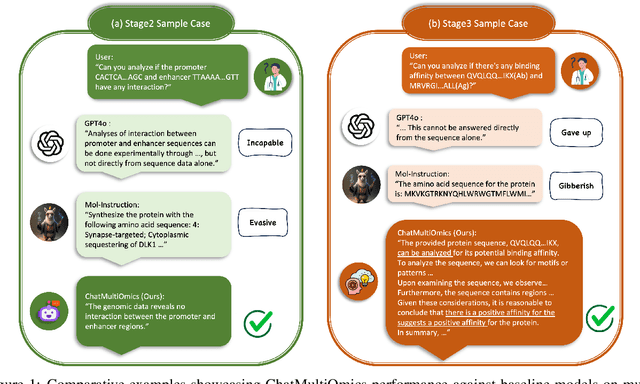

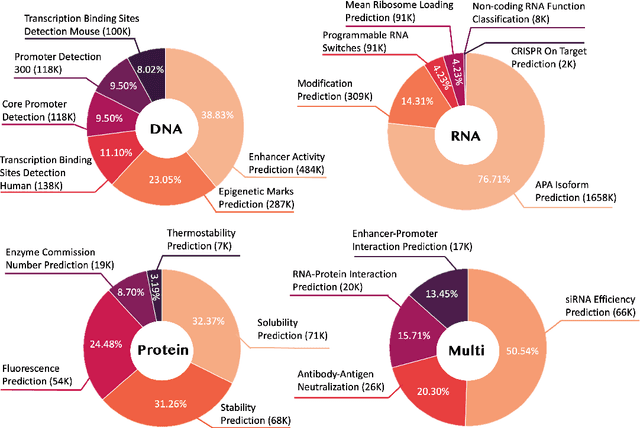
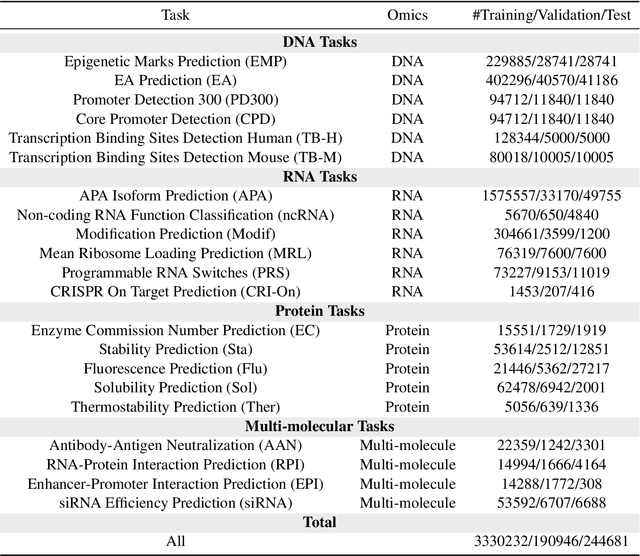
Abstract:Large language models have already demonstrated their formidable capabilities in general domains, ushering in a revolutionary transformation. However, exploring and exploiting the extensive knowledge of these models to comprehend multi-omics biology remains underexplored. To fill this research gap, we first introduce Biology-Instructions, the first large-scale multi-omics biological sequences-related instruction-tuning dataset including DNA, RNA, proteins, and multi-molecules, designed to bridge the gap between large language models (LLMs) and complex biological sequences-related tasks. This dataset can enhance the versatility of LLMs by integrating diverse biological sequenced-based prediction tasks with advanced reasoning capabilities, while maintaining conversational fluency. Additionally, we reveal significant performance limitations in even state-of-the-art LLMs on biological sequence-related multi-omics tasks without specialized pre-training and instruction-tuning. We further develop a strong baseline called ChatMultiOmics with a novel three-stage training pipeline, demonstrating the powerful ability to understand biology by using Biology-Instructions. Biology-Instructions and ChatMultiOmics are publicly available and crucial resources for enabling more effective integration of LLMs with multi-omics sequence analysis.
 Add to Chrome
Add to Chrome Add to Firefox
Add to Firefox Add to Edge
Add to Edge